
BioMed Central
Page 1 of 8
(page number not for citation purposes)
Journal of Immune Based Therapies
and Vaccines
Open Access
Original research
Vaccine based on a ubiquitous cysteinyl protease and streptococcal
pyrogenic exotoxin A protects against Streptococcus pyogenes sepsis
and toxic shock
Robert G Ulrich
Address: Laboratory of Molecular Immunology, Army Medical Research Institute of Infectious Diseases, 1425 Porter Street, Frederick, Maryland
21702, USA
Email: Robert G Ulrich - rulrich@bioanalysis.org
Abstract
Background: The gram-positive bacterium Streptococcus pyogenes is a common pathogen of
humans that causes invasive infections, toxic-shock syndrome, rheumatic fever, necrotizing fasciitis
and other diseases. Detection of antibiotic resistance in clinical isolates has renewed interest in
development of new vaccine approaches for control S. pyogenes sepsis. In the study presented, a
novel protein vaccine was examined. The vaccine was based on a recombinant protein fusion
between streptococcal pyrogenic exotoxin B (SpeB), a cysteinyl protease expressed by all clinical
isolates, and streptococcal pyrogenic exotoxin A (SpeA), a superantigen produced by a large subset
of isolates.
Results: A novel protein was produced by mutating the catalytic site of SpeB and the receptor
binding surface of SpeA in a fusion of the two polypeptides. Vaccination of HLA-DQ8 transgenic
mice with the SpeA-SpeB fusion protein protected against a challenge with the wild-type SpeA that
was lethal to naïve controls, and vaccinated mice were protected from an otherwise lethal S.
pyogenes infection.
Conclusion: These results suggest that the genetically attenuated SpeA-SpeB fusion protein may
be useful for controlling S. pyogenes infections. Vaccination with the SpeA-SpeB fusion protein
described in this study may potentially result in protective immunity against multiple isolates of S.
pyogenes due to the extensive antibody cross-reactivity previously observed among all sequence
variants of SpeB and the high frequency of SpeA-producing strains.
Background
Streptococcus pyogenes is a perennial human pathogen,
causing mild infections and life-threatening diseases
including pharyngitis, impetigo, necrotizing fasciitis,
streptococcal toxic shock syndrome and rheumatic heart
disease. Antibiotic-resistant strains are increasing in glo-
bal distribution [1,2], and a marked worldwide increase
in the prevalence of serious invasive disease caused by S.
pyogenes has occurred in the last two decades [3,4], per-
haps due to the emergence and distribution of more viru-
lent strains. Although the incident is low, the recorded
overall mortality rate is 45% among streptococcal toxic
shock-like syndrome cases [5].
There are currently no licensed vaccines available for pro-
tection against diseases caused by S. pyogenes. Ideally, a
Published: 31 October 2008
Journal of Immune Based Therapies and Vaccines 2008, 6:8 doi:10.1186/1476-8518-6-8
Received: 7 June 2008
Accepted: 31 October 2008
This article is available from: http://www.jibtherapies.com/content/6/1/8
© 2008 Ulrich; licensee BioMed Central Ltd.
This is an Open Access article distributed under the terms of the Creative Commons Attribution License (http://creativecommons.org/licenses/by/2.0),
which permits unrestricted use, distribution, and reproduction in any medium, provided the original work is properly cited.

Journal of Immune Based Therapies and Vaccines 2008, 6:8 http://www.jibtherapies.com/content/6/1/8
Page 2 of 8
(page number not for citation purposes)
vaccine should incorporate antigens from a major viru-
lence determinant or antigens that are ubiquitously
expressed by disparate bacterial strains. Streptococcal
pyrogenic exotoxin A (SpeA) and other secreted superan-
tigen toxins are potential candidates for vaccines because
these proteins are associated with many outbreaks of
streptococcal toxic shock syndrome and are virulence fac-
tors for invasive infections. In addition, bacteremia is
commonly associated with cases of streptococcal toxic
shock [6]. The secreted polypeptide of SpeA (25,700 Mr)
is classified as a superantigen [7] that facilitates bacterial
immune escape by targeting the primary recognition step
in adaptive immunity. The cellular receptors for SpeA are
human major histocompatibility complex (MHC) class II
molecules, primarily HLA-DQ and HLA-DR proteins
expressed on select cell lineages, and the antigen receptors
of T cells (TCRs). The normal antigen-specific signal trans-
duction of T cells is disengaged by SpeA, displacing con-
tacts of MHC-bound antigenic peptides with antigen
combining site elements of the TCR, and results in an ele-
vated polyclonal activation of T cells. Toxic shock may
ensue from pathological levels of tumor necrosis factor
alpha (TNF-α) and other pro-inflammatory cytokines
released in response to secreted superantigens [8,9].
Most, if not all, S. pyogenes M protein serotypes express an
extracellular cysteine protease (streptopain) historically
termed streptococcal pyrogenic exotoxin B (SpeB), though
not homologous in structure or function to SpeA or any
other superantigen. The secreted protease SpeB is also a
bacterial surface molecule with binding activity to lam-
inin and other glycoproteins [10], making it a potential
target of neutralizing antibodies. Further, SpeB is an
important colonization and pathogenicity factor [11],
reported to modify several host substrates. For example,
the interleukin 1β precursor is cleaved by SpeB to produce
active interleukin 1β [12], and the extracellular matrix
proteins fibronectin and vitronectin are also cleaved [13],
thus modulating entry of S. pyogenes into host cells [14].
Although multiple alleles exist, polyclonal antisera gener-
ated against SpeB from any strain react with SpeB from all
S. pyogenes M1 serotypes examined [15]. Further, antibod-
ies against SpeB are detected in patients with invasive S.
pyogenes infections of either streptococcal toxic shock syn-
drome and/or necrotizing fasciitis [16]. The ubiquitous
expression of SpeB by S. pyogenes strains and the con-
served nature of the antigenic determinants recognized by
antibodies are noteworthy features, thus fulfilling major
criteria for a potential vaccine. Collectively, these observa-
tions prompted the presently described development of a
fusion protein comprised of SpeA and SpeB that was used
as a vaccine in experimental models of streptococcal toxic
shock and sepsis.
Methods
Recombinant streptococcal proteins
Genes encoding SpeA (M19350) and SpeB (M86905)
were cloned from a clinical laryngitis isolate of Streptococ-
cus pyogenes by polymerase-chain reaction (pcr) amplifica-
tion. Specific restriction enzyme motifs for cloning were
introduced into the amplified DNA fragment by using the
oligonucleotide primer 5' CTCG CAA GAG GTA CAT ATG
CAA CAA GAC 3' to produce a unique NdeI site, and 5'
GCA GTA GGT AAG CTT GCC AAA AGC 3' to produce a
unique HindIII site. The amplified DNA fragment was
ligated into the EcoRI site of a pcr-cloning vector (Invitro-
gen) and the resulting plasmid was used to transform E.
coli DH5α. The HindIII/EcoRI DNA fragment containing
the full-length SpeA gene minus the signal peptide was
cloned into pET24 vector for expression in E. coli BL21.
Although proteins were also produced with the leader
peptide sequence present, deletion of the leader peptide
appeared to result in a higher yield of protein.
Two different mutants of SpeA were produced by chang-
ing amino acid residue leucine 42 to either arginine or
alanine by using previously described methods [17]. The
first SpeA construct consists of a single mutation at residue
leucine 42 [SpeA (L42R) or SpeA (L42A)], while the sec-
ond construct consists of a fusion between the SpeA
(L42R) and a mutant SpeB protein. The wild-type SpeB
zymogen, isolated from the same strain of S. pyogenes used
to clone SpeA, was truncated by PCR cloning to produce
the mature protein without the prosegment domain (non-
catalytic). A mutant, catalytically-inactive SpeB [SpeB
(C47S)] was constructed by site-specific mutagenesis of
the DNA coding sequence, altering cysteine 47 to serine.
This conservative change maintains the approximate
dimensions of the active-site side chain but prevents pro-
teolytic activity. The SpeB (C47S) DNA was used as a
fusion partner with SpeA (L42R) that was constructed
with the following oligonucleotide primers:
1. SpeA forward primer, including NdeI site:
5' GATATACATATGCAACAAGACCCCGATCCAAGCC 3'
2. SpeA reverse primer, with SpeB overlap:
5' GAGATTTAACAACTGGTTGCTTGGTTGTTAGGTAGAC
3'
3. SpeB forward primer, with SpeA overlap:
5' GTCTACCTAACAACCAAGCAACCAGTTGTTAAATCTC
3'
4. SpeB reverse primer; adding an Amber codon:

Journal of Immune Based Therapies and Vaccines 2008, 6:8 http://www.jibtherapies.com/content/6/1/8
Page 3 of 8
(page number not for citation purposes)
5' GAATTCGGATCCGCTAGCCTACAACAG 3'
For cloning, the SpeA (L42R) gene was used as a PCR tem-
plate and primers 1 and 2 were used to prepare a double-
stranded sequence overlapping with SpeB (C47S). A sepa-
rate PCR reaction with the SpeB (C47S) gene insert using
primers 3 and 4 was performed to generate a double-
stranded DNA fragment overlapping with SpeA (L42R).
The PCR fragments were purified by agarose gel electro-
phoresis and mixed together for a final PCR reaction using
primers 1 and 4, to create the full-length gene fusion of
SpeA (L42R)-SpeB (C47S). This full-length fragment was
cloned into the vector pT7Blue (Novagen) and the
sequence was confirmed.
Protein production
The SpeA (L42R, L42A) and SpeA (L42R)-SpeB (C47S)
fusion genes were subcloned into pET24b (+) for expres-
sion in E. coli BL21 host strains. Production of the recom-
binant proteins and purification methods were as
previously described [17,18]. The endotoxin levels of pro-
tein preparations were less than detection limits, as deter-
mined by a limulus amebocyte lysate assay (Cambrex,
Walkersville, MD). Purified wild-type SpeA and affinity-
purified rabbit antibodies specific for either SpeA or SpeB
were obtained from Toxin Technology (Sarasota, FL) and
used to confirm identity of the recombinant proteins by
Western blots. Proteins (2 μg/lane) were electrophoresed
through 12% polyacrylamide gels in the presence of SDS
(1%), with dithiothreitol (2 mM). Gels were then elec-
troblotted onto a protein-binding membrane (Amer-
sham), and blocked (2 h, 37°C) with 0.2% casein in PBS.
The membrane was then incubated (1 h, 37°C) with a 1/
200 dilution of affinity-purified, rabbit anti-SpeA or SpeB
(Toxin Technologies, Sarasota, FL). Unbound antibody
was washed from the membrane using PBS, and bound
antibody was detected with peroxidase conjugated, goat
anti-rabbit antisera, using a commercial color develop-
ment kit (BioRad, Richmond, CA).
HLA-DR/DQ binding assay
The DR1 homozygous, human B-lymphoblastoid cell line
LG2 was used to detect binding of the SpeA proteins to
MHC class II molecules, as previously described [17]. In
brief, LG2 cells (4 × 105/50 μl) were incubated 40 min
(37°C) with wild-type or mutant SpeA in Hanks balanced
salt solution (HBSS) containing 0.5% bovine serum albu-
min. The cells were washed with HBSS and then incu-
bated with 5 μg of affinity-purified rabbit anti-SpeA
antibody (Toxin Technology) for 1 h on ice. Unbound
antibody was removed, and the cells were incubated with
FITC-labeled goat anti-rabbit IgG (Organon Teknika
Corp., Durham, NC) on ice for 30 min. The cells were
washed and analyzed by flow cytometry (FACScan; Bec-
ton Dickinson & Co., Mountain View, CA). Controls con-
sisted of cells incubated with affinity purified anti-TSST-1
and the FITC labeled antibody without prior addition of
SpeA.
T-lymphocyte responses
Lymphocyte proliferation was used to measure biological
responses to the streptococcal proteins, as previously
described [17]. Human peripheral blood mononuclear
cells, obtained from consenting volunteers, were purified
by Ficoll-hypaque (Sigma, St. Louis, MO) buoyant density
gradient centrifugation. The cells were cultured in RPMI-
1640 with 5% FBS for 72 h, and pulsed-labeled for 12 h
with 1 μCi [3H]-thymidine (Amersham, Arlington
Heights, IL). Cells were harvested onto glass fiber filters,
and [3H]-thymidine incorporation into the cellular DNA
was measured by a liquid scintillation counter (BetaPlate,
Wallac Inc., Gaithersburg, MD).
Serum antibody
Serum levels of total IgG were determined by enzyme-
linked immunosorbent assays (ELISA). Polystyrene 96-
well plates (Nunc) were coated with a 1 μg/ml solution of
antigen in 0.05 M sodium carbonate buffer (pH 9.6) over-
night (4°C). The plates were blocked for 2 h (37°C) with
0.2% casein in PBS (138 mM NaCl, 2.7 mM KCl) and then
washed three times with PBS. Serum samples were serially
diluted in 0.02% casein in PBS and incubated in the anti-
gen-coated plates for 1 h (37°C). The plates were washed
three times with PBS and a 1:2000 dilution of goat anti-
mouse IgG, HRP conjugated (Southern Biotechnology),
was added in 0.02% casein PBS. The plates were incubated
for 60 min (37°C), washed three times with PBS and then
developed (30 min, 22°C) with TMB substrate (3,3',5,5'-
Tetramethylbenzidine, Pierce). The reactions were
stopped with the addition of 0.5 M H2SO4 and the absorb-
ance determined at 450 nm wavelength.
Vaccinations
HLA-DQ8/human CD4+ transgenic mice were described
previously [19]. Pathogen-free, 10–12-week-old BALB/c
mice were obtained from Charles River (National Cancer
Institute, Frederick, MD), maintained under pathogen-
free conditions, and fed laboratory chow and water ad libi-
tum. For vaccinations, mice were each injected 3 times (2
weeks between injections) intramuscularly (i.m.) with 10
μg of proteins (100 μl) combined with 100 μl MPL adju-
vant (MPL™ + TDM+ CWS Emulsion, RIBI ImmunoChem
Research, Inc., Hamilton, MT). This research was con-
ducted in compliance with the Animal Welfare Act and
other federal statutes and regulations relating to animals
and experiments involving animals and adhered to the
principles stated in the Guide for the Care and Use of Labo-
ratory Animals, National Research Council, 1996.

Journal of Immune Based Therapies and Vaccines 2008, 6:8 http://www.jibtherapies.com/content/6/1/8
Page 4 of 8
(page number not for citation purposes)
Bacterial sepsis and toxic shock
The β-hemolytic Streptococcus pyogenes strain RIID231
(spea+, speb+), a human laryngitis isolate, was used as a
source of streptococcal genes and bacteria for mouse chal-
lenges. Bacteria were propagated in Todd-Hewitt broth
cultures (0.2% yeast extract) and single colonies were iso-
lated after growth on sheep blood agar plates containing
the same media to prepare bacteria for challenge studies.
Streptococci were collected from broth cultures in mid-log
growth phase, washed three times by gentle centrifugation
in PBS and the density (A670) was adjusted by using PBS
(22°C). Colony-forming units were confirmed by growth
of diluted bacteria on sheep blood agar plates. For mouse
challenges, bacteria diluted in PBS were injected (105 CFU
in 100 μL) into tail veins using a tuberculin needle and
syringe (27 g), followed 4 h later by i.p. administration of
75 μg (50 μL) of E. coli lipopolysaccharide (LPS; Difco,
Detroit, MI). For challenge with SpeA, mice were injected
i.p. (50 μL) with toxin diluted in PBS.
Results
Vaccine design
The genes encoding SpeA and SpeB were cloned from a
strain of S. pyogenes originating from a patient with laryn-
gitis. The binding interface between SpeA and human
MHC class II molecules consists of contacts located in the
N-terminal domain that are in common with other bacte-
rial superantigens [17]. Leucine 42 of SpeA protrudes
from a reverse turn on the surface of SpeA to potentially
form a major hydrophobic contact with HLA-DQ or HLA-
DR receptor molecules. Mutants of SpeA were constructed
to alter leucine 42 (L42) and reduce HLA-DR binding.
Mutations of the SpeA amino acid residue 42 to arginine
or alanine (L42R or L42A) resulted in greatly diminished
interactions with cell surface HLA-class II molecules (Fig-
ure 1A), as measured by flow cytometry.
Human T-cell proliferation in response to these mutants
was next assessed. Both SpeA mutations of L42 resulted in
greatly diminished activation of human lymphocytes
(Figure 1B). Although alanine and arginine substitutions
of L42 resulted in similar levels of attenuated MHC class
II binding, arginine substitution (L42R) produced the
greatest reduction of T-cell responses (Figure 1B) and was
therefore chosen for further study.
A catalytically inactive SpeB was constructed by mutating
cysteine at position 47 [SpeB (C47S)] and used as a fusion
partner with SpeA (L42R). The predicted 54 kDa protein
was detected by polyacrylamide gel electrophoresis (Fig-
ure 2A). The SpeA (L42R)-SpeB (C47S) fusion was catalyt-
ically inactive towards peptide substrate (data not
shown), using a previously reported assay [20]. In addi-
tion, rabbit antibodies specific for either SpeA or SpeB
both detected SpeA (L42R)-SpeB (C47S) by Western blot
analysis (Figure 2A). Although an additional recombinant
protein was produced to incorporate the SpeB prosegment
in the final SpeA-B fusion, this was not used further due to
poor stability in solution.
Mouse antibody response to SpeA (L42R)-SpeB (C47S)
and protection from SpeA-toxic shock
Immune recognition in vivo of the recombinant strepto-
coccal proteins was next examined. BALB/c mice were vac-
cinated three times with 10 μg of SpeA (L42R) or SpeA
(L42R)-SpeB (C47S), allowing two weeks between injec-
tions. Although vaccination with either SpeA (L42R) or
the SpeA (L42R)-SpeB (C47S) produced high antibody tit-
ers, antibodies from SpeA (L42R) vaccination recognized
only SpeA (Figure 2B), whereas, antibodies from the SpeA
(L42R)-SpeB (C47S)-vaccinated mice recognized both
SpeA and SpeB (Figure 2B). Seroconversion (IgG)
occurred after the first vaccination with SpeA (L42R)-SpeB
(C47S) compared to two injections required for the SpeA
(L42R) vaccination (Figure 3). Although these data con-
firmed the potent immunogenicity of the SpeA constructs,
the inbred mouse was an inadequate model to demon-
strate protective immunity. Within reasonable physiolog-
ical limits, wild-type SpeA was not lethal for several
inbred mouse strains examined. Therefore, a transgenic
model was used, consisting of C57BL/6 mice expressing
human CD4 and HLA-DQ8 [21,22]. Wild-type SpeA was
previously shown to be lethal at relatively low concentra-
tions for the HLA-DQ8 mice [23]. The lymphocyte
response from the HLA-DQ+ mice to SpeA (data not
shown) was very similar in dose effect to those obtained
with human mononuclear cells. Non-vaccinated HLA-
DQ8 mice succumbed to SpeA challenge, whereas, vacci-
nation with either SpeA (L42R) or SpeA (L42R)-SpeB
(C47S) fully protected HLA-DQ8 transgenic mice from
challenge with the same amount of wild-type SpeA (Table
1).
Vaccination with SpeA (L42R)-SpeB (C47S) and protection
from streptococcal sepsis
Inconsistent results were obtained in attempts to model S.
pyogenes sepsis in several inbred mouse strains. Therefore,
the HLA-DQ8 transgenic mice were also used to examine
vaccine efficacy in bacterial sepsis. Mice vaccinated as
above were injected (i.v.) with live bacteria followed 4 h
later by i.p. administration (75 μg) of E. coli LPS. Survival
was monitored for 10 d after challenge. The co-adminis-
tration of LPS, as previously documented for toxic shock
[24], produced a measurable fatal disease (3–7 d) in mice
injected with live S. pyogenes (Figure 3). The majority
(80%) of vaccinated mice were protected from lethal sep-
sis in contrast to the unvaccinated control mice (Figure 3).
Mice vaccinated with only SpeA (L42R) were not pro-
tected from bacterial sepsis (data not shown). However, it
was unclear if these results were due to a limitation of the

Journal of Immune Based Therapies and Vaccines 2008, 6:8 http://www.jibtherapies.com/content/6/1/8
Page 5 of 8
(page number not for citation purposes)
Biological activity of SpeA mutantsFigure 1
Biological activity of SpeA mutants. A. Mutations of amino acid position leucine 42 of SpeA to arginine or alanine resulted
in greatly diminished interactions with cell surface MHC class II molecules, measured by laser fluorescence-activated flow
cytometry and FITC-labeled rabbit anti-SpeA antibody. B. Mutations of amino acid position leucine 42 of SpeA to arginine or
alanine resulted in greatly diminished activation of human lymphocytes. Human T-cell proliferation was assessed by [3H]thymi-
dine incorporation (12 h pulse) after 60 h of culture. Each data point represents the mean of triplicate determinations; SEM ≤
5%.
Relative binding, median fluorescence
A
A
50
40
0
10
20
30
Spe
A
w
t
wild-type
1 10 100 1000
Spe
A
L
4
2
A
S
R
pe
A
L
4
2
L42R
L42A
0
SpeA [ g/ml]
1 .1.01.001. 0001. 0 0 0 0 1
wild-type
L42A
L42R
B
2
0000
0
4
0000
60000
80000
1
00000
0 1 10 100 1000
[3H]thymidine incorporation, cpm
SpeA [ M]
0.01 0.1 1.0 10 100 1000

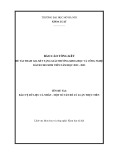
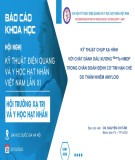

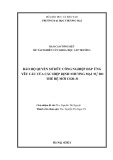
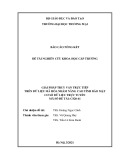
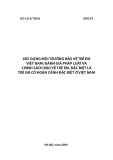

![Vaccine và ứng dụng: Bài tiểu luận [chuẩn SEO]](https://cdn.tailieu.vn/images/document/thumbnail/2016/20160519/3008140018/135x160/652005293.jpg)

















